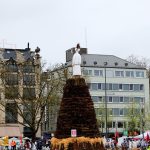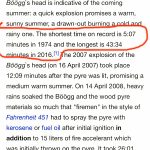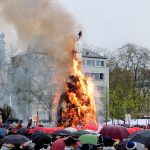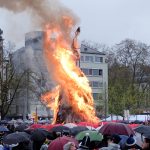Hello everyone! Today I’m gonna introduce to you an annual spring holiday in the Swiss city of Zürich – Sechseläuten. It is a traditional spring holiday celebrated in its current form, usually on the 3rd Monday of April since the early 20th century. However, in 2017 it’s on the forth Monday of April, 24th April, 2017 and 16th April, 2018.
As for the Sechseläuten this year, the bad thing is it was raining heavily and I couldn’t properly watch the parade of the Zünfte (guilds) (Usually they give flowers or small presents to the people watching, and if you’re lucky, by the end you can get a huge bunch of beautiful flowers). Parade of the Zünfte is a very colorful afternoon parade of the 26 guilds in their historic dress costumes, each with its own band, most with a sizable mounted ‘Reitergruppe’, and horse drawn floats, to the ‘Sechseläutenplatz’ at the lakeshore where the Böögg is burnt. I was wearing my water-proof windbreaker and yet, I got soaked when I arrived home. However, the good thing is that I witnessed a new record in history. Probably you still don’t know what I’m talking about because you still don’t know what’s Sechseläuten. Now I’ll introduce to you the history as well as the tradition of this festival.
History and Tradition
The roots of the festival go back to medieval times when the first day of summer working hours was celebrated in the guildhalls across the city. City ordinances strictly regulated the length of the working day in that era. During the winter semester the workday in all workshops lasted as long as there was daylight, but during the summer semester (i.e. starting on Monday following vernal equinox) the law proclaimed that work must cease when the church bells tolled at six o’clock. Sechseläuten is a Swiss German word that literally translates into “The six o’clock ringing of the bells”. Changing to summer working hours traditionally was a joyous occasion because it marked the beginning of the season where people had some non-working daylight hours.
Burnings of Böögg figures (the Swiss German term for “bogey”, in origin scary-looking ragdolls) in spring are attested in various places of the city from the late 18th and early 19th century, without direct connection to the Sechseläuten. The combination of the Sechseläuten parade and the burning of an official Böögg was introduced in 1902.
From 1902 until 1951, the holiday used to be held on the first Monday following vernal equinox. On that day, the Fraumünster bell, for the first time in the year, tolled to mark the end of working hours at 6 p.m. (historically the time of sunset on vernal equinox). The holiday was moved to the third Monday of April in 1952. Because of the later date, and because of summer time introduced in 1981, the lighting of the Böögg’s pyre at 6 p.m. has now moved to several hours before nightfall. Additionally, because of its present date, the holiday is often within a week of 1 May, leading to a stark contrast between the upper class dominated Sechseläuten and the working class holiday of May Day. This proximity of the major festivals of two political poles of the society of Zürich has led to various interferences in the past, for example the abduction of the Böögg in 2006 by leftist “revolutionaries” a few days before the Sechseläuten. Since then, several Bööggs are held in reserve with the main one stored at a bank nearby the Sechseläutenplatz (the open area in front of the Opernhaus near Bellevue where most Zürich open air activities take place). Since 2010 the guilds of Zürich allow the women of Gesellschaft zu Fraumünster to practice Sechseläuten, usually just being guests of the guilds respectively the Constaffel society, but still not being as an official guild in Zürich.
Weather oracle
Popular tradition has it that the time between the lighting of the pyre and the explosion of the Böögg’s head is indicative of the coming summer: a quick explosion promises a warm, sunny summer, a drawn-out burning a cold and rainy one. The shortest time on record is 5:07 minutes in 1974 and the longest is 43:34 minutes in 2016. The 2007 explosion of the Böögg’s head (on 16 April 2007) took place 12:09 minutes after the pyre was lit, promising a medium warm summer. On 14 April 2008, heavy rains soaked the Böögg and the wood pyre materials so much that “firemen” in the style of Fahrenheit 451 had to spray the pyre with kerosene or fuel oil after initial ignition in addition to 15 liters of fire accelerant which was initially thrown on the pyre. It took 26:01 minutes for the Böögg’s head to explode which indicates a poor weather summer.
In 2016 the head exploded after 43 minutes and 34 seconds, setting a new record. I think it’s kind of accurate as this summer was for sure cooler than last summer. I remember there were only around 2 weeks that I felt so hot that I wanted to buy a fan, but last year, the hot days are more than a month.
This is a fun event, particularly for children I think as they are so many firecrackers in the snowman and it keeps exploding for quite some time, which feel like new year lol. However, choose a spot where you can see the Böögg but not too close. It should be absolutely safe but still, safety first. For example, this year, the head didn’t explode on top, instead, it fell off on the ground and then exploded, which is quite scary if you stand too close (I know there is large room between the snowman and the closest row you can stand in as there are people riding horses in the circle, but still nothing can ever be too safe).
I hope you have fun and safe experience at next year’s Sechseläuten and I hope it won’t break this year’s record, otherwise probably you will have to wait in the snow for 50 mins lol. Don’t forget, it’s the on the 24th of April, the forth Monday of April, not as usual the third.


































